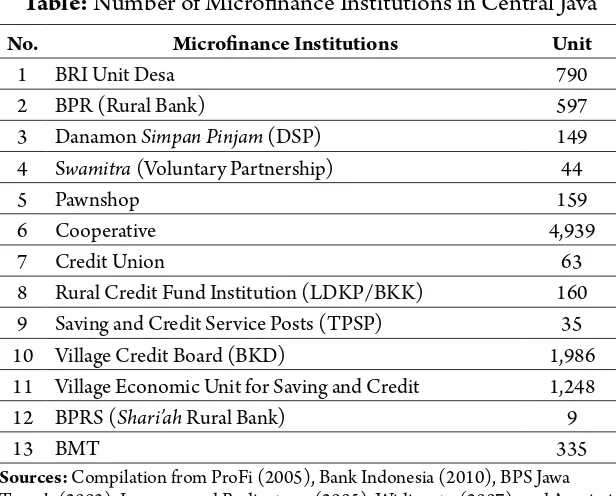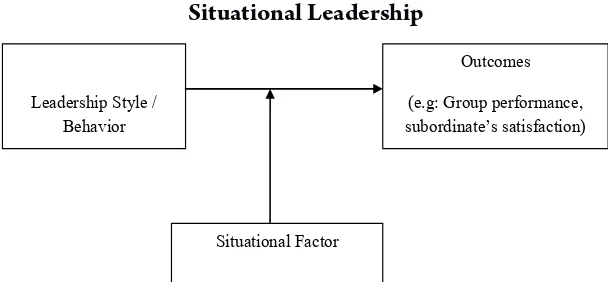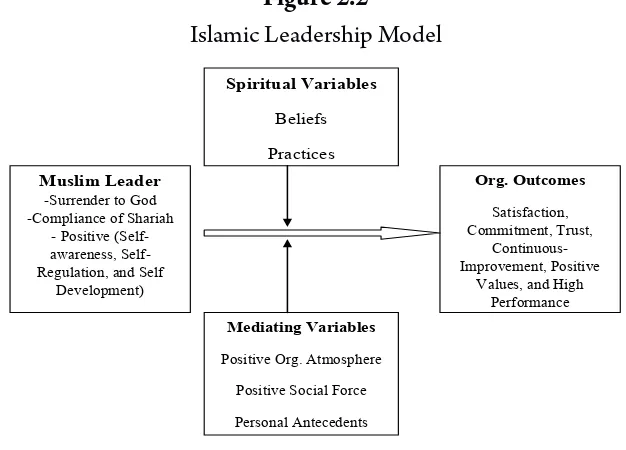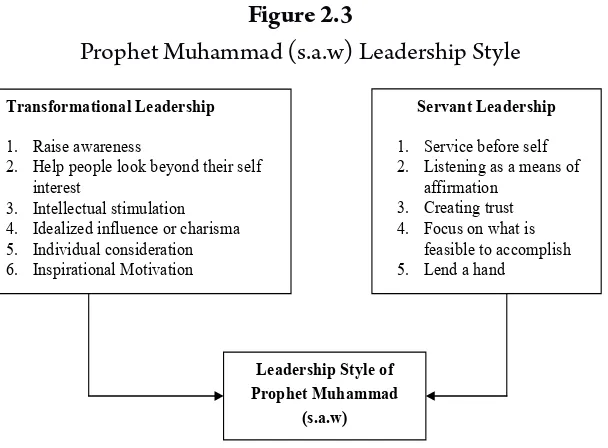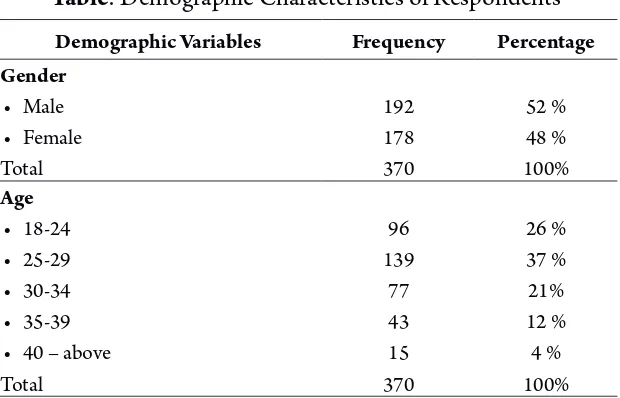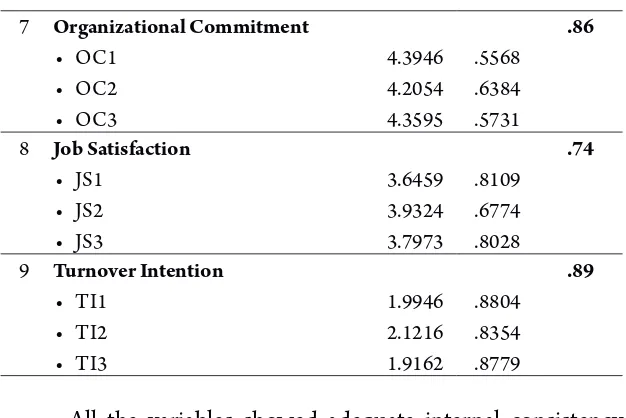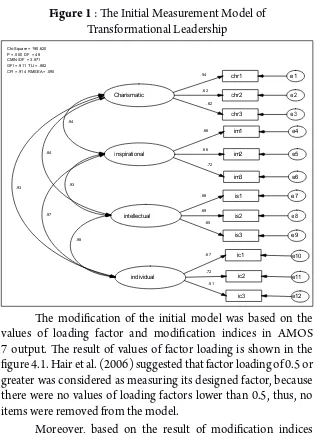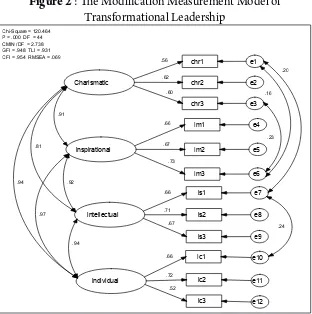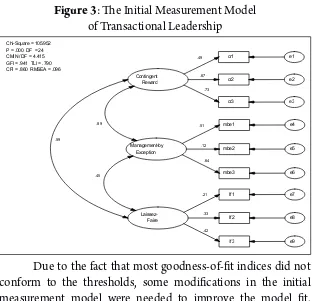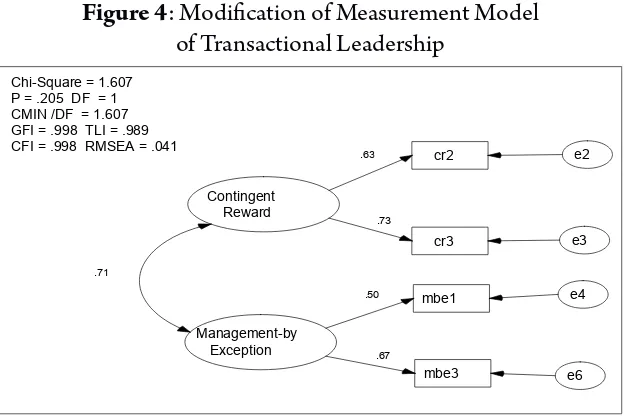Wahibur Rokhman, Ph.D
Islamic Management
Practices in Islamic
Microfinance
“An Empirical Study”
Islamic Management
Practices in Islamic
Wahibur Rokhman, Ph. D
Islamic Management Practices in Islamic Microfinance: An Empirical Study , Cet.1 Wahibur Rokhman, Ph. D. Idea Press Yogyakarta Cet. 1. 2016.
viii + 182 hlm, 15.5 cm x 23.5 cm ISBN: 978-602-6335-04-3
I. Judul II. Wahibur Rokhman, Ph. D
@ Hak cipta Dilindungi oleh Undang-Undang
Memfotocopy atau memperbanyak dengan cara apapun sebagian atau seluruhnya isi buku ini tanpa seiizin penerbit adalah tindakan tidak bermoral dan melawan hukum
Islamic Management Practices in Islamic Microfinance:
An Empirical Study
Penulis:Wahibur Rokhman, Ph. D Desain sampul: Fatkhur Roji Setting Layout: Abdul ‘Alim Cetakan I: Agustus 2016
Dicetak oleh Penerbit Idea Press Yogyakarta Jl. Amarta Diro RT 58 Pendowoharjo, Sewon, Bantul
Yogyakarta, Telp. 0274-6466541, 0817263952 Email: [email protected]
Anggota IKAPI DIY Copyright@2016 penulis Hak Cipta Dilindungi Undang-Undang
ﭓ ﭒ ﭑ
Assalamu’alaikum Wr. Wb.
First of All, I thank to Allah SWT that this book is finished. He is the ultimate one who gives me strength, health, endurance to work hard. This book was written out of my own teaching experience at STAIN Kudus, Indonesia. For several years I have been teaching the Human resources management at undergraduate class and Islamic Microfinance at postgraduate program STAIN Kudus. From that experience, I realized that there has been a major gap between conventional management and Islamic management. The book is a compilation from many resources that relevant to the practice management in Islamic microfinance in Indonesia.
This book is organized in several chapters includes: (1) Islamic microfinance, (2) Leadership in Islamic perspective, (3) Islamic Work Ethics, (4) Organizational justice in Islam, (5) Work outcomes, (6) Management Practices in Microfinance, (7) Summing Up. The structures of the topics of this book, students are expected to be able to understand the various theories of management in practices especially in Islamic Microfinance.
I would like to take this opportunity to express my profound gratitude to the people whose help and support made this book such as: chairman of STAIN Kudus, lecturers, staffs and students. The work would not have been possible without the assistance of several people who help this project.
sincere thanks to my family. This book would not have been possible without their continues love, support to me. Special thank to my mother and my father for their understanding and patience. Last but not least, special thanks to my wife for her big love to me and to all my children, chania and igna who are continues inspiration.
The work may have a lot of weaknesses, I would expect Suggestions and criticisms to improve this book ahead, and May Allah helps us.
Thank you, Wassalamu’alaikum Wr. Wb.
Best Regards,
ACKNOWLEDgEMENTS v
TABLE OF CONTENTS
vii
Chapter 1: ISLAMIC MICROFINANCE
Introduction 1
•
Microfinance in central Java 1
•
Islamic Microfinance Institutions 3
•
Baitul Maal Wat Tamwil (BMT) 5
•
Chapter 2: LEADERSHIP IN ISLAM
Introduction 11
•
Leadership 12
•
The Trait Theories
1. 15
The Behavioral Theories
2. 18
The Contingency Theories
3. 20
Transformational Leadership 25
•
Idealized Influence / Charisma
1. 27
Inspirational Motivation
2. 28
Intellectual Stimulation
3. 39
Individualized Consideration
4. 30
Transactional Leadership 31
•
Contingent Reward
1. 32
Management-by-Exception
2. 33
Laissez-Faire
3. 33
Leadership in Islamic Perspective 34
•
Transformational Leadership in Islam 38
•
Introduction 43 •
Protestant work ethic 45
•
Islamic Work Ethic 48
•
Chapter 4: ORgANIzATIONAL JUSTICE
Introduction 53
•
Distributive justice
1. 54
Procedural Justice
2. 56
Interactional Justice
3. 58
Justice in Islamic perspective 60
•
Chapter 5: WORK OUTCOMES
Introduction 61
•
Organizational Commitment 61
•
Job Satisfaction 63
•
Turnover Intention 65
•
Chapter 6: EMPIRICAL RESEARCH
Background of the Study 71
•
Purpose of the study 73
•
Research Questions 74
•
Research Method 75
•
Results 96
•
Chapter 7: DISCUSSION AND CONCLUSION
Introduction 143
•
Discussion of the Findings 144
•
Implications of the Study 156
•
Recommendations 158
•
Limitations and Suggestions For Future Research 159 •
Conclusions 161
•
ISLAMIC MICROFINANCE
Introduction
The Islamic microfinance is one of the microfinance institutions (mfI) that has the fastest growth rate among the mfIs in central Java, Indonesia. The Islamic microfinance in Indonesia, which is called Baitul Maal Wattamwil (BmT), is an important new source for the establishment of micro institutions and while gaining support from the Islamic community, they have also rapidly spread the establishment of microfinance institutions. There are approximately more than 515 institutions spread over some regencies in central Java province, Indonesia.
Microfinance in Central Java
central Java is a province in the republic of Indonesia. It is located between the West Java and the east Java provinces with a total area of around 32,548 km2. according to the BPs
statistics, Indonesia, the population is around 32, 1 millions, which becomes the third most populous province in Indonesia after West Java and east Java. administratively, central Java province consists of 29 regencies and six municipalities which are divided into six residencies (semarang, surakarta, Pati, Pekalongan, Banyumas, and Kedu) (BPs, 2010).
The economic development, under the Governor of central Java, has been directed to accelerate the economic recovery and to strengthen the sustainable economic development which is based on micro, small and medium enterprises (msmes), and cooperatives. In central Java, there are approximately 6.5 million msmes or 30 percent of the number msmes in Indonesia (Widiyanto, 2007), which represents the prime difference of central Java economy compare to the other provinces in Indonesia.
furthermore, to support the huge number of msme, the banks need to provide a capital or credit to support the development and the success of msme. nevertheless, msmes have difficulties in obtaining credit facilities from the banking system, because most of them cannot fulfill the 5c requirements of the bank (character, capital, collateral, capacity, and condition) (Ismawan and Budiantoro, 2005). In order to solve the capital need, several community groups have been currently supported by the government established microfinance Institutions (mfIs). This has given great benefits to the micro-enterprises considered as special institutions that provide credit facilities for the micro-enterprises (Widiyanto, 2007; sebel and agung, 2008 ).
There are several types of mfIs in central Java, namely, BrI Unit Desa, rural Bank (Bank Perkreditan Rakyat / BPr), Pawnshops, Danamon Simpan Pinjam (DsP) Bank Bukopin and Swamitra Units, Village credit Boards (Badan Kredit Desa
/ BKD), rural credit and fund Institution (Lembaga Dana Kredit Pedesaan / lDKP), cooperative, Village saving and credit Units (Unit Ekonomi Desa-Simpan Pinjam / UeDsP), savings and credit service Posts (Tempat Pelayanan Simpan Pinjam
Islamic Microfiaice
MFIs, the researcher is always faced with secondary data which are not readily available because there is not a single central body that can collect, process, and disseminate the MFIs data for updating purposes at the moment (Sebel and Agung, 2008). Table below describes the number of MFIs in Central Java from some resources.
Table: Number of Microfinance Institutions in central Java
No. Microfinance Institutions Unit
1 BrI Unit Desa 790
2 BPr (rural Bank) 597
3 Danamon Simpan Pinjam (DsP) 149
4 swamitra (Voluntary Partnership) 44
5 Pawnshop 159
6 cooperative 4,939
7 credit Union 63
8 rural credit fund Institution (lDKP/BKK) 160 9 saving and credit service Posts (TPsP) 35
10 Village credit Board (BKD) 1,986
11 Village economic Unit for saving and credit 1,248
12 BPrs (Shari’ah rural Bank) 9
13 BmT 335
Sources: compilation from Profi (2005), Bank Indonesia (2010), BPs Jawa Tengah (2003), Ismawan and Budiantoro, (2005), Widiyanto (2007), and asosiasi BmTs (2008).
Islamic Microfinance Institutions
The Islamic microfinance institutions (ImfIs) are one of the mfIs group that has the fastest growth rate among the mfIs in central Java. ImfIs consist of two institutions:
Bank Perkreditan rakyat (BPrs/ syariah rural bank ) 1.
and
Baitul Mal Wat Tamwil
2. (BmT).
services, such as savings, credits for Muslims from the middle and the lower income groups. Nevertheless, the BPRS development is quite stagnant, such as, the number of BPRS until today is only 9 institutions (BI, 2010) as result of which it has little impact on the Islamic microfinance services in central Java (seibel and agung, 2008). on the hand, BmTs in central Java are fast growing. There are approximately more than 500 institutions spread over some regencies, however, only 335 BmTs are registered in the BmT association.
Islamic Microfiaice
Baitul Mal Wat Tamwil
(BMT)
The word Baitul Mal Wat Tamwil (BmT) comes from the two terms, i.e., baitul mal and baitul tamwil (azis, 2008). as such, a more specific definition can be derived as follows:
Baitul mal
1. means the house of wealth which refers to the social mission of BmT as an institution that will distribute the donation of zakat, infaq, and shadaqah to the persons who are eligible to receive ( Mustahiq).
Baitul tamwil
2. means the house of wealth development, which is the business mission of BmT. It is meant to conduct business development efforts and investments in productive economy in order to improve the quality of micro and small entrepreneurs, especially, by encouraging saving activities and supporting the financing of economic activities.
BmTs operate under cooperative principles which are regulated under the cooperative law of act no. 25/1992. They are registered with the ministry of cooperatives, small and medium enterprises, but not all BmTs operate as legal entities. The establishment of BmT has to be attested by a notary and BmT statutes are standardized and include subjects, such as, identity, area of operation, objectives, and transaction under profit-loss sharing principle and using the Islamic moral values as guidance in the transactions (sakai and marijan, 2008).
members are involved in the decision-making processes (Holloh, 2001).
The regulation obligates that the BmT management consists of at least three persons, depending on the BmT size. In practice, however, three persons are not sufficiently practicable to run an institution properly. In this case, the usual minimum number of staff in the Islamic microfinance institution is five persons in the following five positions:
a general manager, who is responsible for BmT operations, 1.
works planning, operational policies, reporting and financing (loan) approvals;
a financial manager, who is responsible for servicing, 2.
guiding and supervising the borrowers as well as for planning, analysis, reporting in the field of financing, design of deposit products, fund mobilization and administration;
an accountant, who is responsible for the financial 3.
administration and reporting, and the calculation of income and profit sharing;
a cashier, who is responsible for financial transactions and 4.
daily cash administration; and
a real sector manager, who is responsible for marketing 5.
and dissemination of market information (Holloh, 2001; Brouwer and Dijkema, 2002).
However, practically all the staffs go to the field to collect deposit and to distribute credit, and only one or two staff members are always available in the office to serve the customers. In addition, every institution also has an advisor who does not deal with daily activities but gives advice on how to efficiently solve certain problems and the management of the institution (Brouwer and Dijkema, 2002).
Islamic Microfiaice
which have spread in all regencies. However, it is difficult to get the actual number since some BmTs have collapsed while some are new establishment. In central Java, there is an institution (asosiasi BmT Jateng/ central Java BmT association) which is established by the BmT’s administrator that organizes the activities of BmTs. BmTs association recorded that the number of BmT in central Java were around 335, but only less than half are active to submit reports to the association (asosiasi BmT, 2008). The table 3.2 describes the number of BmTs, the estimated assets that they have and also the approximate number of staff who work in each BmTs.
Table: assets and number of BmTs and approximate staffs
BMT asset size Number
of BMTs
Approximate Number Of Staff
BmTs’ assets below rp 500
mil 50 around 5
BmTs’ assets between rp 500
mil and 1 Billion 134 5-10
BmTs’ assets between rp 1
Billion and 10 Billion 126 10-15
BmTs’ assets above rp 10
Billion 25 more than 15
Source: asosiasi BmT (2008)
This condition gives more opportunities to micro-enterprises to obtain financing especially for the micro-micro-enterprises that cannot access the bank and mfIs that are constrained by the 5c criteria. This is more so, especially, when the micro-enterprises consider the interest rate as riba which is highly forbidden by the Islamic law (sakai and marijan, 2008). as such, BmT is considered as an institution that supports the enhancement of the quality of economic and micro-enterprise business transactions based on the Islamic law and the establishment and development of BmT are closely related to the effort of the national economic development (Widiyanto, 2007).
as a viable financial institution, BmT is offering products and services similar to the Islamic banks and syari’ah rural banks (BPrs). However, it has a different market sector in terms of patronage, where the Islamic banks mainly cater for the middle class and the white collar muslims. BPrs on the other hand mainly provide services for muslims from the middle and the lower income groups. While BmT usually serves the muslim customers who run small and medium enterprises and whose access to the banks is relatively limited, some customer overlapping occurs among the Islamic bank, BPrs and BmT (sakai and marijan, 2008).
although it has a big impact on the micro-institution financial operations, the research on BmT is limited. for example, the study which was conducted by sakai and marijan (2008) found some characteristics of the BmT in central Java as described below:
most BmTs are established and run by muslim’s 1.
entrepreneurs with a strong commitment to institute social justice based on the Islamic principles. leadership and commitment significantly affect the operational success as much as the presence of regulations.
To reach the social justice objective, most BmTs offer 2.
Islamic Microfiaice
programs, and business/entrepreneurial training) to their members and the community.
There are associations and institutions which are related 3.
to BmTs, such as, BmT center, PInBUK and BmT associations that are actively creating self-regulation codes and standard operational procedures for their group. The lack of a proper understanding of the functions of 4.
BmT is because of the limitation of promotions which has resulted in the negative perception that BmTs are charitable organizations. such perceptions have created problems for BmTs in enforcing repayment of loans. some BmTs also operate other business ventures. success 5.
or failure of their business has a direct impact on BmTs’ operations.
LEADERSHIP IN ISLAM
Introduction
Leadership is an essential element in any organization irrespective of religious association. This is because of the role of a leader as the key person in managing and coordinating the whole activities in an organization. Islam is a comprehensive religion which covers all aspects of life, including the concept of leadership. The Prophet muhammad (s.a.w) stated: “that if there are three embarking on a journey, one of them should be
appointed as a leader” (as cited by abu Dawud). The goals of
leadership in Islam are directing and guiding the members to what is good in the world and the Hereafter (ali, 2009), with emphasis on brotherhood, social economic justice and create a balanced between the material and spiritual need.
Today, business organization attempts to adapt the increase of the changing of environment, the competitive intensity and changing of customer need and desire is becoming more diverse and complex (Bass, 1985). This condition requires organizations that are able to respond the continuous changes in resources, technologies, and marketing and distribution system. For doing so, organization needs leaders to challenge the status quo, to create visions of the future, and to inspire organizational
members to achieve the visions (Robbin, 2005) and also leaders who have capabilities to adapt the changing environment.
Leadership is no doubt one of the most intensively studied concepts in social sciences (Frey et al., 2009). This is perhaps justifiable given the fact that leaders play an important role in ensuring organizational effectiveness (Bass, 1985). despite many studies that have been conducted, in a comprehensive review of leadership literature (see meta-analyses by Bono and Judge, 2004), however, not much is known about leadership in islamic perspectives. in this paper, firstly, we will examine the differentiation between management and leadership. secondly, we will discuss on islamic leadership and finally we will review on transformational leadership which was performed by propet muhammad (s.a.w).
Leadership
Leadership is no doubt one of the most intensively studied concepts in social sciences (Tabassi and abu-Bakar, 2010; Frey et al., 2009). This is perhaps justifiable given the fact that leaders play an important role in ensuring organizational effectiveness (Tabassi and abu-Bakar, 2010). despite many studies that have been conducted, in a comprehensive review of leadership literature (see meta-analyses by Bono and Judge, 2004; Judge and piccolo, 2004), Yulk and Van Fleet (1992) concluded that the field of leadership is still in a state of ferment and confusion.
Leadership ii Islam
organizational structures and monitoring results against the plans. Leadership, in contrast, is about coping with the change and… developing vision in the future”. Furthermore, greenberg and Baron (2008) explain the differences. They said that leadership is to create the essential purpose or mission of the organization and the strategy attainment, while manager is to implement the vision. Based on the three distinctions above, leadership is more strategic and powerful to create and design adaptive organization than management. however, both management and leadership are essential for organizational success (robbins and Judge, 2008; nienaber, 2010). highly effective leaders may not necessarily have management skills but highly effective leaders do have access to those that do have management skill (nienaber, 2010). Table 2.1 describes the comparison between leadership and management.
motivation, the wants and the needs, the aspirations and the expectations of both leaders and followers”.
Table: Leadership versus Management
Leadership Management
Ideas
Shape and influence process
Creating a vision innovation
Coping with change anticipating crises doing the right thing empowerment developing Focusing on people Focusing on concepts removing barriers
Facts Control Content
developing a plan administration
Coping with complexities resolving crisis
doing things right supervision directing
Focusing on tasks Focusing on personalities setting policies
Sources: modification from: Bennis (1989) and robbins (2005).
Leadership ii Islam
the roles through the influencing process. The third element is organizational objectives. in this case, leaders and followers need to work together to set objectives that should be achieved and the leader should provide the direction based on the shared idea between leader-follower. Change is the fourth element. in this instance, leaders should involve in influencing followers to adapt to the global environmental changes. as such, leaders must take risks and try new ideas for the future organization. The fifth element is people. Leadership is about leading people. as such, effective leaders and followers should work together with the people in their environments and support them to succeed.
Over the years a number of approaches to studying leadership have been pursued. These approaches of leadership theories reflect an idea of leadership based on an individual, a specific trait, and the effect of the environment on a leader. These perhaps explain the fact that theory of leadership has developed starting from trait theory until the new paradigm such as transformational leadership. The major approaches will be discussed below.
The Trait Theories
1.
The trait theory was one of the first systematic attempts
to study leadership in the 20th century. during this time,
et al., 2003). By identifying the leader’s trait, successful leaders could be quickly assessed and put into leadership positions.
One of the most prominent leadership theories in the earliest study of trait theory was the great Man Theory. It sought to identify the effectiveness of the leader’s traits. The theory holds that people are born with these traits and only great man possessed them (Taylor, 2009). scholars attempted to isolate the superior qualities and explain leadership styles in term of personality and character traits revealed.
hughes, Ginnett, and Curphy (2002) suggest that this leadership theory embraces the notion that history is shaped by great men who have capacity to lead the masses. Leaders like John F. Kennedy, mahatma Gandhi, soekarno and nelson mandela etc. exemplify the Great man Theory. many leadership studies based on this theoretical framework were conducted in the 1930s, 1940s, and 1950s.
stogdill (1948) analyzed over 124 empirical studies conducted between 1904 and 1947. in his first survey, he identified a group of successful leaders. The result of this survey showed that individuals in various groups become leaders because of the following traits: intelligence, alertness, insight, responsibility, initiative persistence, self confidence, and sociability (northouse, 2009).
Leadership ii Islam
concluded that “a person does not become a leader by virtue of the possession of some combination of traits…the pattern of personal characteristics of the leaders must bear some relevant relationship to characteristics, activities, and goals of followers” (p.64). Furthermore, he suggested that leadership requires more than just the study of people, but also the study of situation.
Lord et al. (1986) reassessed man (1959) and found that personality traits in leadership are intelligence, masculinity and dominance (Lussier and achua, 2007). Kirkpatrick and Locke (1991) found that leaders are different from non leaders on six traits: drive, the desire to lead, honesty and integrity, self confidence, cognitive ability, and knowledge of the business.
according to northouse (2009), some researches in the traits theory found the following characteristics:
Intelligence
1. refers to the leaders to have a strong verbal
ability, perceptual ability, and reasoning appears to make one a better leader.
Self confidence
2. refers to the ability to be certain on one’s
competencies and skills. This includes a sense of self esteem, self assurance, and belief.
Determination
3. refers to the desire to get the job done and
includes initiative, persistence, dominance and drive. Integrity
4. refers to the quality of honesty and
trustworthiness Sociability
5. refers to a leader’s inclination to seek out
pleasant social relationship like being friendly, outgoing, courteous, fateful, and diplomatic.
findings are congruent with the personality factors identified in the Big-Five model including: extroversion, agreeableness,
conscientiousness, emotional stability, and openness
to experience.
a lot of trait studies were conducted to discover the list of qualities, but no one has come up with the traits that would guarantee leadership success. hersey, Blanchard, and Johnson (1996:103) provided a brief summary regarding trait theory studies:
“empirical research suggests that leadership is a dynamic process, varying from situation to situation with changes in the leader, the followers, and the situation. Therefore, although certain traits may help or hinder a given situation, there is no universal set of traits that will ensure leadership success”.
The trait research did not consider the impact of situational variables that might moderate the relationship between leader and traits as well as measure the leadership effectiveness (armandi et al., 2003; Taylor, 2009). as a result of the lack of consistent findings linking individual traits to leadership effectiveness, empirical studies of leader traits were largely abandoned in the 1950s.
The Behavioral Theories
2.
This theory began in the early 1950s, when most of the leadership researches shifted away from trait theory to focusing on what the leader actually did on the job (behavioral) (armandi et al., 2003; Lussier and achua, 2007). The premise of this stream of research was that the behaviors exhibited by the leaders are more important than their physical, mental, or emotional traits (dubrin, 1995).
Leadership ii Islam
that are well-known in this regard are: Ohio State Studies and Michigan Leadership Studies.
The ohio state studies analyzed how individuals acted when they were leading a group in organization (Greenberg and Baron, 2008). This research compiled a list of 1800 examples of leadership behavior, and then reduced the list to 150 items that appeared to be examples of good leader behaviors (Yulk, 2006). The items were eventually used to form leader Behavior Description Questionnaire (lBDQ), which was used to determine the common leader behaviors. This research found two general types of leadership behaviors: initiating structure and consideration. Initiating structure referred to the way in which a leader initiated activities in a group, organized them and
defined the way work was to be accomplished which involved: planning, organizing, and coordinating the work of subordinates. Consideration measured the extent to which a leader was concerned about the welfare and well-being of the members of the group such as: showing concern for subordinates, being
supportive, recognizing subordinates’ accomplishments
and providing subordinate’s welfare (hughes et al., 1999; duBrin, 1995).
Likert summarized the behavior into three types that differentiated between effective and ineffective managers (Likert, 1961):
Task-oriented behavior. Effective managers do not a.
perform the same work as their subordinates. They complete planning and task scheduling activities that provide high, but reachable goals. This is similar to the initiating structure of ohio state study.
relations-oriented behavior. effective managers show b.
trust, confidence, friendly behavior, and support in their subordinates. They manage in a more general method as opposed to direct or close supervision. The effective managers attempt to build the self-worth and importance of the subordinate. This is similar to consideration in Ohio state study
participative leadership. Group meetings are used to c.
involve subordinates in decision making, communications, and to solve any conflicts or open issues. The effective manager did use participative methods, but also remained responsible for all decisions and results.
The assumption of the above approach was that there d.
were certain behaviors that would be universally effective for leaders. Unfortunately, empirical research has not demonstrated consistent relationship between task oriented and person-oriented leader behaviors and leader effectiveness (house and aditya, 1997). Like trait research, leader behavior research did not consider situational influences that might moderate the relationship between leader behavior and leader effectiveness.
The Contingency Theories
3.
Leadership ii Islam
theories try to predict which type of leadership style will be most effective in different type of situations (Bryman, 1986; Tabassi and Abu-Bakar, 2010). Bryman (1986) expresses the basic structure of this approach in Figure 2.1. Contingency theories gained prominence in the late 1960s and 1970s. There are four theories that are well-known in this approach: fielder’s theory, Path-Goal theory, the Vroom-Yetton-Jago decision-making model of leadership, and the situational leadership theory.
Figure 2.1 Situational Leadership
source: Bryman, 1986, p.126
Fielder’s theory, introduced in 1967, was the first to specify how the situational factors interact with the leader traits and behavior to influence the leadership effectiveness (Tabassi and abu-Bakar, 2010; Luthan, 2005). Fiedler suggested that the leadership effectiveness depends on two factors. One is the degree to which the leadership situation gives the leader control and influence over the group process and the group performance. The second factor reflects an attribute of the person, an aspect of the leader’s goal or focus of concern. Fiedler developed a personality measure, that is the least preferred co-worker (LpC) scale, to identify leadership style. The LpC instrument measured esteem for the leader’s least preferred co-worker and the score was used to generalize leadership style (house and aditya, 1997).
Leadership Style / Behavior
Outcomes
(e.g: Group performance, subordinate’s satisfaction)
Bass (1990) reported that Fiedler developed three leadership factors, which indicated a leader’s ability to influence
followers. They are: first, leader-member relation, which refers to
the respect and trust that followers have for the leader. second, task-structure, it refers to responsibility of subordinate which is highly structured and measured. Third, position power, it refers to the control that the leader has over subordinates’ rewards and punishments.
This study found that task-oriented leaders were more effective when the situation was either highly favorable or highly unfavorable. in contrast, person-oriented leaders were more effective in the moderately favorable or unfavorable situations. This study did not propose that leaders should adapt their style to different situation. But rather, leaders with different leadership styles would be more effective when they were placed in the situation that matched to their preferred style (northouse, 2009).
The second theory in contingency approach is the path-Goal theory. This theory was developed by house in 1971 and refined in 1974 by house and mitchell. The theory revealed that leader can influence subordinates’ perception of work and the paths to attaining stated goals (silverthone, 2001). The theory proposed two attributes to determine which leader behaviors will be more effective: the subordinates’ attributes and work-setting attributes. The subordinate attributes are authoritarianism, internal-external orientation, and ability. in addition, work-setting attributes include task, formal authority system, and primary work group (schermenhorn et al., 1994).
Leadership ii Islam
between the leader and subordinates; and (d) achievement-oriented leadership sets ambitious goals for subordinates and communicates a high level of confidence in their ability to complete tasks. The effective leader used a combination of the above styles to meet the needs of followers, which in turn increased productivity.
The path-Goal theory has two contributions to the leadership theory: first, training could be used to change leadership behavior to fit the contingency situation. second, the leader could be taught to diagnose the situation and to learn how to change the contingency (schermenhorn et al., 2004). however, there are also some criticisms, for instance, interpretation of the meaning of the theory can be confusing because of its complexity and incorporation of so many aspects of leadership. Furthermore, it fails to explain adequately the relationship between leadership behavior and worker motivation (silverthone, 2001). similarly, Yulk (2006) showed that the theory focuses only on a few aspects of leaders’ behavior that are conceptualized in overly abstract and broad category.
another theory is the Vroom-Yetton decision making model. This theory focused on decision making rather than style of leadership (hughest et al., 1999). it focused primarily on the degree of subordinate participation that is appropriate in the different situations and emphasizes on the decision-making style of the leader. The styles are labeled ai, aii, Ci, Cii and G. These styles range from strongly autocratic (ai) to strongly democratic (G) (house and aditya, 1997).
subordinates should participate in decision making. This theory holds that: (a) organizational decision should be of the highest quality and (b) subordinate should accept and be committed to organizational decisions that are made (duBrin, 1995; hughest et al., 1999).
The last contingency approach is the situational leadership theory. This theory was introduced by hersey and Blanchard in 1969 and was revised in 1977. The theory suggests that the key contingency factor affecting leaders’ choice of leadership style is on the level of followers’ readiness (robbins and Judge, 2009). readiness is the extent to which people have the ability and willingness to accomplish a specific task.
hersey and Blanchard (1977) attempted to match four leadership patterns: task-oriented, dynamic, relations-oriented and delegating, with four levels of maturity (low, moderately low, moderately high, and high) of subordinates. maturity was identified as the most significant variable in determining leadership style. Follower maturity is responsible for the relationship between leader behavior and leader effectiveness. This model identifies four leadership styles: telling, selling, participating, and delegating. Telling style is best for low follower readiness; selling style is best for low to moderate readiness; participating style is best for moderate to high readiness; and delegating style is best for high readiness. This theory requires the leader to develop the capability to diagnose the demands of situations and then choose and implement the appropriate leadership response (robbins and Judge, 2009).
Leadership ii Islam
Transformational Leadership
Over the past two decades, transformational leadership theories have emerged as one of the most popular approaches to understanding leadership effectiveness (e.g. Piccolo and Colquitt, 2006; Barling et al., 2008). in contrast to the earlier approaches, the new emerging theories focus on attempting to explain how leaders can accomplish extraordinary things and arouse follower to have higher level of thinking (piccolo and Colquitt, 2006). These later approaches also emphasize on the importance of leaders’ inspiring subordinates’ admiration, dedication, and unquestioned loyalty through articulating a clear and compelling vision ( see Bass, 1985; Yulk, 2006; pillai et al., 1999; Frey et al., 2009).
it was Burns (1978) who introduced the concept of transformational leadership. he explains the concept of transforming leadership as follows:
“such leadership occurs when one more person engages with other in such a way that leaders and followers raise one another’s higher levels of motivation and morality. Their purposes, which might have started out as separate but related, as in the case of transactional leadership become fused, power bases are linked not as counter weights but as mutual support for common purpose”. (Burns, 1978: 20)
Extending Burns initial theory, Bass (1985) also approached transformational leadership by discussing Maslow’s hierarchy of needs. The concept of the maslow’s hierarchy of needs is that an individual must satisfy basic needs for survival to some reasonable degree before bothering about his or her own safety and security. only after this, the individual can focus upon the need for love and affiliation with family and friends. after fulfilling the aforementioned, the individual can then concentrate on self esteem and recognition. The highest level of the hierarchy is the need for self-actualization or realizing one’s own potential (Tabassi and abu-Bakar, 2010). Transformational leaders increase and arouse the follower’s need to the higher level, which can produce extraordinary effort (Fitzgerald and schutte, 2010; Frey et al., 2009).
according to Bass, the transformation can be attained in any one of three related ways. First, it is by raising the level of awareness. By doing so, the degree of consciousness related with the importance and value of designated outcomes and how to achieve them. second, this leadership emerges when an individual interest is transcended for the sake of the higher goals which an organization or a team has. Third, by altering to a higher level of need in maslow’s hierarchy, transformation may be attained (Bass, 1990).
although the work of Bass was based on Burns’ work, Bass’ work was different from Burns’ work. as Bass (1985: 22) mention that:
“Burns and i are different in the three ways. he sees transformational leadership as the opposite end of a single continuum from transactional leadership. Conceptually and empirically, we find leaders will exhibit a variety of patterns of transformational and transactional leadership. most leaders do both, but in different amounts”.
Leadership ii Islam
Different views of relationship between transformational leadership and transactional leadership are due to different
findings in empirical researches. Burns (1978) found that transformational and transactional leadership’s forms are distinct from each other in political area. however, some other findings such as Waldman Bass and Yammarino (1990) indicate that these two dimensions are highly correlated, suggesting that transformational and transactional processes are related and occurred together. in addition, the effect of transformational leadership on work outcome is positively stronger than that of transactional leadership (Waldman et al., 1990). Based on this finding, it is suggested that transformational leadership
is an extension of transactional leadership and some leaders
have a profile of the full range of leadership. That is, they have
both transformational and transactional factors (Bass and
steidlmeier, 1999).
Bass further described that transformational leadership is based upon four dimensions. The four dimensions in transformational leadership are idealized influence (or charisma), inspirational motivation, intellectual stimulation and individualized consideration. These are discussed in the following sections.
Idealized Influence/ Charisma
1.
idealized influence (charisma) is described as an attribute of a leader who behaves as a role model, and possess high standard of moral and ethical conduct and is respected by follower (Bass and steidlmeier, 1999). Bass defined and described charisma as below:
“Charisma has been used to describe leader who by the power of their person have profound and extraordinary effects on their followers. Charismatic leaders inspire in their followers unquestioning loyalty and devotion
without regard to the followers’ own self-interest”.
Based on this definition, leaders who have charisma tend to gain respect, confidence and loyalty from their subordinates. moreover, they also acquire a strong individual identification with their followers, who also develop intense feelings for their supervisor (dubinsky et al., 1995).
Transformational leaders behave in ways that make them role models for their followers. such leaders are admired, respected and trusted. Followers identify with these leaders and want to emulate them. They avoid using power for personal gain and in fact use their power only when needed. moreover, leaders who exhibit idealized influence are able to obtain the required extra efforts from followers to achieve optimal levels of development and performance (Bass and avolio, 1992).
Bass also maintains that there are requisite abilities, interests, and personality traits of the charismatic leaders: first, charismatic leaders raise self-confidence and self-esteem. second, charismatic leaders set extraordinary determination and capability apart from followers. Third, leaders with charisma have insights into the needs, values, and hopes of subordinates. Finally, charismatic leaders nurture in the followers, the desire to achieve a want for the team’s goals (Bass, 1997).
Inspirational Motivation
2.
inspirational motivation refers to the leaders who have capacity to create a convincing vision for the future based on values and ideas (Bono and Judge, 2004). The leader’s vision is not only based on tangible rewards but also provides meaning by addressing the higher order needs such as the personal growth of the followers (humpheys, 2005). in addition, the leader also raises the expectations and confidences of the followers to achieve the ultimate goals.
Leadership ii Islam
inspirational leadership can be self-generated by leaders to the followers. By using inspirational leadership, the self-interests of followers can be raised above the group interest (Fitzgerald and Schutte, 2010). in addition, inspirational leaders also stimulate enthusiasm and motivation among followers to achieve the objectives of the group and organization.
Bass stated that there are a number of requirements for inspirational leadership (Bass, 1985). First, inspirational leaders motivate followers to do extra effort with an action-orientation. in this, the emphasis of the leader is upon actions, and not bureaucratic formalities (e.g., administrative protocols, organizational structures, etc.). second, inspirational leaders built the confidence within subordinates. Third, transformational leaders are able to inspire belief in the greater cause of the group. Finally, inspirational leaders are able to increase the expectations of their subordinates, which in turn lead directly to extra-efforts and outcomes of performance (Bass, 1997).
Intellectual Stimulation
3.
intellectual stimulation is Bass’s third factor associated with transformational leadership. This is characterized by promoting intelligence, rationality, logical thinking and careful problem solving (Fitzgerald and schutte, 2010). Transformational leaders stimulate their followers’ efforts to be innovative and creative by questioning assumptions, reconstructing problems and approaching old situations in new ways. Followers are encouraged to try new approaches, and their ideas are not criticized if they differ from the leaders’ ideas (humpheys, 2005).
encouraged to question their own way of doing things or to break the past.
Leaders exhibiting intellectual stimulation actively encourage subordinates to look at old problems or methods in new ways. They seek to foster employee creativity and stress rethinking, reexamination of assumptions, and use of intelligence and reasoning rather than unsupported opinions (Dubinsky et al., 1995; Piccolo and colquitt, 2006). The followers are able to conceptualize and understand the nature of the problems faced by the organization. moreover, because of this augmented followers understanding, they will be better capable of participating in the problem solving process (Fitzgerald and schutte, 2010).
The leader stimulates followers to rethink old ways of doing things and to reassess their old values and beliefs. This dimension is concerned with the degree to which followers are provided with interesting and challenging tasks and encouraged to solve problems in their own way (pounder, 2001).
Individualized Consideration
4.
individual consideration may be characterized by the leader’s ability to foster participative management and focus upon individual employee’s need for growth and participation. Leaders who have individual consideration treat every employee as individual with unique needs, capabilities and concerns (arnold and Loughlin, 2010). The result of this leadership behavior is that followers’ satisfaction and productivity will be augmented (Bass, 1985).
Leadership ii Islam
Transformational leaders employing individualized consideration are also able to delineate among differences in followers (Piccolo and Colquitt, 2006). in essence, every subordinate is different from the other, and the transformational leader understands this in addressing employee issues. Finally, individual counseling is also important. Leaders are expected to be counselors and responses to followers needs are critical in the success of the leader.
mentoring is also an essential element in this dimension. in this manner, the values of leaders can continue within the organization through the protégés (northouse, 2009). moreover, individual consideration implies that a leader also takes on the role of a coach or mentor. This role involves the ability to recognize individual differences concerning needs for autonomy, encouragement, support, responsibility, structure and instructions. Leaders coach and mentor the followers in order to provide continuous feedback and links with organization’s mission (arnold and Loughlin, 2010).
Transactional Leadership
Transactional leadership refers to the exchange relationship between the leader and followers (Bass and avolio, 1992; piccolo and Colquitt, 2006). They receive something from the other in return for something else. in other word, the leaders give subordinates something that they want (such as salary or bonus) in exchange for something that the leaders desire (such as productivity or goal attainment). Burns described transactional leadership as leaders who are based on bureaucratic authority and legitimacy within organization. They also tend to focus on task completion and employee compliance (deluga, 1990).
and resources essentially via strategies of control. It emphasizes on work standards, assignments and task-oriented goals and as a cost benefit exchange process reinforces its perceived inferiority to the transformational notion. Furthermore, this leader also manipulates the followers’ valued outcome in exchange for follower’s compliance with leadership wishes (Fitzgerald and schutte, 2010; Lussier and achua, 2007).
Bass (1998) has identified the following dimensions of transactional leadership: contingent reward, management-by-exception (mBe), and laissez-faire. These are discussed in the next sections.
Contingent Reward
1.
Contingent reward refers to the agreement between a leader and a follower on what the follower needs to do to be rewarded or to avoid punishment. moreover, they accept interconnected roles and responsibilities to attain the goals (Bass, 1985; northouse, 2009). in general, the forms of contingent reward are praises for work well done and recommendations for pay increases, bonuses and promotion. in contrast, contingent punishment also can be taken when an employee fails to fulfill the manager’s expectations.
Leadership ii Islam
Management-by-Exception
2.
In this dimension, the transactional leadership will devise a system to prevent any deviation from standards and on a constant basis take the steps required to keep followers on course. This style may be appropriate in situations where the personal safety of employees is at risk (Bass, 1998; Piccolo and colquitt, 2006). although less emphasis is placed on goal-setting and leader-follower contact in contingent reward, the relationship remains characterized by ethical values (aronson, 2001).
The leader will tend to stand by and apply corrective measures only after the divergence from standards has occurred. The ethical leader may, therefore, lack sufficient time for personal attention to followers’ needs but will nonetheless operate with a genuine concern for their well-being and a desire for them to succeed.
Laissez-Faire
3.
The laissez-faire is the third dimension of transactional leadership according to Bass. This dimension is essentially a non leadership, as the leadership is absent (Bass, 1999). This type of leader tends to withdraw from leadership role and offer little in the terms of either direction or support. according to deluga (1990) that laissez-faire leadership is a passive leader who is reluctant to influence the follower or give direction.
give direction. Hence, the subordinates are given considerable freedom of action (Deluga, 1990).
Furthermore, this style is normally ineffective in leading and managing subordinates. Bass (1997) found that there was a negative association between laissez-faire leadership and variety of subordinate performance, effort and attitude. however, there have been studies that have demonstrated that laissez-faire style is not always ineffective. For example Bass (1960) found that sometimes the autonomy of subordinates enhances the subordinates’ performance (Bass, 1985).
Leadership in Islamic Perspective
Leadership is an essential element in any organization irrespective of religious association. This is because of the role of a leader as the key person in managing and coordinating the whole activities in an organization. islam is a comprehensive religion which covers all aspects of life, including the concept of leadership. The prophet muhammad (s.a.w) stated: “that if there are three embarking on a journey, one of them should be appointed as a leader” (as cited by abu dawud). The goals of leadership in islam are directing and guiding the members to what is good in the world and the hereafter (rice, 1999; saleh, 2007; ali, 2009), with emphasis on brotherhood, social economic justice and create a balanced between the material and spiritual need.
Leadership ii Islam
human derivations and behaviors. Third, the Islamic approach of leadership is a human oriented approach rather than a production-oriented approach (al-Buraey, 1985).
In Islam, Prophet muhammad (s.a.w) was a perfect role model of a leader. He had shown how to act and behave in
managing the Ummah which is explained in Hadith and Sunnah.
The life of muhammad (s.a.w) presents a practical example of how
leaders behave toward their followers. allah says (Qur’an 33:21):
“You have indeed in the Apostle of Allah a beautiful pattern of (conduct) for anyone whose hope is in Allah and the final day and who engages much in the praise of Allah”
although the study of leadership is one of the most important fields of modern time, and with the Qur’an and the
Sunnah provide us with numerous references for understanding
the islamic approach to leadership. nonetheless the muslim intellectuals have failed to give it its proper due. as a result, they have been unable to formalize an islamic theory of leadership (saleh, 2007). most of the attempts were not aimed to formulating an islamic theory of leadership, but rather were trying to prove that islam had sufficient resources to formulate such a theory.
The word leadership in arabic language is same as Khilafa,
Umara or Wilaya. ibn Khaldun explained the word Khilafa as
the activities to assist people to live in accordance with the islamic rules as guidance for their interests in this world and in hereafter. it is the vicegerent duty on behalf of allah to guard the
religion and to manage life. Furthermore, Umara is a person who
is entrusted to take care of the affair of other people in certain society (hafidhuddin and Tanjung, 2006). ibn Taymiya defines
“wilaya” as maintaining the religion of the people such that, if it is
lost, they will be the losers. also wilaya entails maintaining a life
36
leadership as trust (amanah). It represents a psychological contract between a leader and followers that he/she will try his/ her best to guide them, to protect them, and to treat them justly. According to Altalib (1991) and Chowdbury (2001) leadership in Islam is a process of inspiring and coaching voluntary followers in effort to fulfill a clear as well as share vision and the element of complete surrender to allah in its entire ramifications. islam does not separate the day to day life from spiritual life, it rather integrates the socio-economic, legal, cultural and all aspects of human life. Therefore, it is reasonable to explore how islam influences leadership practices of its follower’s everyday. The focus of leadership in islam is on doing good deeds for the sake of allah, the muslim community and humankind (Kader, 1973 in aabed, 2006). Toor (2007) proposed islamic leadership model which consists of several variables such as muslim leaders, spiritual variable, mediating variables and organizational outcomes (see figure 2.2).
Figure 2.2
islamic Leadership model
Source: modified from Toor (2007: 61).
Muslim Leader
-Surrender to God -Compliance of Shariah
- Positive (awareness, Self-Regulation, and Self
Development)
Spiritual Variables
Beliefs
Practices
Mediating Variables
Positive Org. Atmosphere
Positive Social Force
Personal Antecedents
Org. Outcomes
Satisfaction, Commitment, Trust,
Continuous-Improvement, Positive
Leadership ii Islam
According to Hafidhuddin and Tanjung (2006) the definition of leadership in islam can be explained in two terms: umara or ulil amri and Khadimul ummah. Firstly, umara or ulil amri is a person or group of people who are entrusted to take care of the affair of other people in certain society. These leaders are responsible for managing the interest of their follower. They should be able to formulate various strategies and approaches to minimize conflict of interests that may arise among their
followers. secondly, khadimul ummah is defined as leaders
who serve the people. The leaders must be put in a position of serving the need of people. in a company context, leaders should create the balance of interest from the owners, employees and surrounding environment. The concept of leadership in islam
combines umara and khadimul ummah. The combination of
these two is necessary needed in order to produce a qualified leader who can bring harmony and prosperity in an organization (hafidhuddin and Tanjung, 2006).
Based on the earlier studies on leadership from islamic perspective, aabed (2006) concluded that there are nine important components of the islamic leadership. First, leadership in islam is rooted in belief and willing submission to the creator,
allah. it centers on serving him based on: Iman (faith in God),
control change in order to achieve the stated objectives. Ninth, leaders should have some leadership qualities such as conviction, justice, sacrifice, eloquence, sound decision-making.
Transformational Leadership in Islam
in both islamic and Western literatures, the transformational leadership approach views the leaders and followers as two partners who set goals and targets for the group together. as partners, they help the group to develop self-confidence and a sense of achievement (aebed, 2006; Beekun, 2007). The nature of transformational leadership in islam is
participatory leadership which is known as shura (discussion) in
decision making process (aebed, 2006).
according to aebed (2006) transformational leadership adopts a down to earth approach for involvement and for providing the opportunities to work together and assists each other. This is compatible with islamic values and as such, the leader will bring out the best in those whom he/she leads to transform society to fulfill its mission. These characteristics are demonstrated by prophet muhammad (s.a.w) who transformed
the society in arabia from the Jahilliyah (the age of ignorance)
into the light of islam.
Furthermore, Beekun (2007) explained that the leadership style of prophet muhammad (s.a.w) was transformational leadership (see figure 2.3), because of some characteristics that are discussed below:
Raising people’s awareness
1. . The prophet increased the
Leadership ii Islam
(s.a.w) was not only aware of what is right, good and wholesome in Allah’s creation, he also made his followers aware of the importance and value of following the right path (Beekun, 2007).
Figure 2.3
Prophet Muhammad (s.a.w) Leadership Style
Source: Beekun (2007: 39).
Helping people look beyond their self interest
2. . Muhammad
(s.a.w) encouraged his followers to elevate the need for achievement and self actualization through intellectual and spiritual rethinking. He guided his Ummah to advance beyond focus on temporary material satisfaction to a permanent fulfillment (Beekun, 2007). For example,
during the Hijrah from makah to madinah, muhammad
(s.a.w) encouraged his followers to look at the future of the Ummah. he brought together the Muhajireen and the Ansor into a spirit of brotherhood after his settlement in madinah.
Intellectual stimulation
3. . a notable attribute of
transformational leader is that he challenges organizational norms, encourages divergent thinking and pushes
32
Transformational Leadership
1. Raise awareness
2. Help people look beyond their self interest
3. Intellectual stimulation 4. Idealized influence or charisma 5. Individual consideration 6. Inspirational Motivation
Servant Leadership
1. Service before self 2. Listening as a means of
affirmation 3. Creating trust 4. Focus on what is
feasible to accomplish 5. Lend a hand
Leadership Style of Prophet Muhammad
followers to develop innovative strategies (Bass, 1985). This character is important for challenging the bad tradition during the darkness (jahiliyah) time. The first
word of revelation:”Iqro’”, implies that muslims should use
their intellectual and spiritual knowledge to get happiness in the world and in the hereafter. islam has always been against the type of ideological stereotype. muhammad (s.a.w) not only encouraged his Ummah to search for self-enhancement, but rather to get closer to, and serve their creator (Beekun, 2007).
Idealized influence or charisma
4. . it refers to a leader who
has a high standard of moral and ethical conduct, and who engenders follower trust in and emotionally identify with the leader (Bass, 1985). muhammad (s.a.w) was an ethical and charismatic leader. allah describes him (in the Qur’an 68: 4) as being endowed with Akhlaq (ethics), “You are of the highest noble characters”. muhammad (s.a.w) demonstrated deep emotional intelligence and his commitment to being a servant leader (Beekun, 2007). he was repelling evil with good. Through kindness and forgiveness, he was able to rise above the assumed traditions of retaliation and blood vengeance.
individual consideration and attention. it refers to a 5.
Leadership ii Islam
Inspirational motivation. It refers to a leader with a strong 6.
WORK ETHICS
Introduction
Ethics derived from the greek word “ethos” which means custom or habit. Ethic is the study of values and customs of persons or groups and covers the analysis and employs the concept such as right and wrong, good and evil, and responsibility (Beekun, 1997). It is about what should be done and what should be avoided as human beings, and as members of a group or a society and in the different roles in life.
sometimes the word “ethics” is used synonymously and interchangeably with morality. But some experts like to differentiate between ethics and morals. They argue that ethics are about social values and morality is about personal values. But in practice, courses on moral philosophy cover the same material as courses on ethics (ciulla, 2003), and both are important as guidance in human relations.
There are some reasons for the importance of ethics. First, ethics give a baseline for understanding the concepts of right and wrong. The function of ethics here is as a standard for a guidance and evaluation of human behavior. second, ethics is a mediator for a dealing or contact with other persons. Unethical attitudes warrant negative responses from people. Third, ethics are a source advice that guides humans on how to act morally in
certain situations and how to show others the correct behavior (Beekun, 1997; Ali, 2005).
Ethics are built in the individual; they come from within.
The individual’s ethics can be influenced by some factors such as family, religious values, ethnic beliefs, personal values and morals and life experiences (Beekun, 1997). it also can be culturally developed given that it is influenced by a combination of social preferences and patterns, family education, religious teachings, and ethnic beliefs and values. This combination creates a cultural and social norm as a base of the ethics of humankind. Beekun (2007) expresses the factor determinants of individual ethics as shown in figure below.
Figure: Determinants of individual Ethics
Source: Beekun, (1997:3).
one of the most important activities in human life is work. Work is an activity that is related with the social and economical side of life. social relations at work are needed for establishment of the equilibrium in individual and social life. Therefore an ethical guidance that regulates activities in the work place is needed. it is usually called work ethic.
Legal Interpretation
Organizational Factor
Individual factors
Stage of Moral development
Personal values and personality
Family influence
Peer influences
Work Ethics
Work ethic is a system of values or beliefs that guides employees’ attitudes and behaviors in the workplace. it reflects on an individual’s attitudes towards some aspects of work, including preference for activity and involvement, attitudes toward financial and non financial rewards and the desire for rising career mobility (cherrington, 1980). it can be described as both a social norm and a set of individual characteristics of the worker. cherrington (1980) suggests that besides social norm, work ethic is an attribute to promote the accountability and responsibility of the worker; it also has an intrinsic value exclusive of the external rewards (hill and Fouts, 2005). Wayne and chapman (1992) view work ethics as a social obligation that referred to usefulness, importance, or general worth that people assign to some behavior or conception related to work.
Because workers come to work with different values and backgrounds, they need ethical guidance that should be followed by every individual in the organization, such as ethics. it is generally believed that work ethic is an essential attribute in the work place. A survey of managers found that almost 80 percent of them agreed that productivity is suffering because the work ethic has decreased in their organizations (Lipset, 1990).
Experts have viewed work ethics from various perspectives. some of them have the opinion that the truth of the work ethics are from the agreement among the group in the organization. in contrast, some of them have opinions that the truth of the work ethics comes from God as the creator. God made humans in his image, he created a regulation that is suitable for humankind. Based on this way of thinking, the work ethics concepts have spread to a variety of religions in the world. Notable examples are the Protestant and the islamic Work Ethic.
Protestant Work Ethic
Spirit of Capitalism. The book addressed the issue of why people pursue material gain for its own sake and not solely for necessity. Weber saw that the root of unintended and unforeseen reaction to the protestant reformation in the 16th century. The PWE is a set
of beliefs and values that emphasizes asceticism, industriousness, individualism, conservation of resources, deferment of immediate satisfaction, and overall valuing of work as the most worthwhile way to spend one’s time (Weber, 2002). According to Beit-hallahmi (1979: 263), PWE “an orientation towards work which emphasizes dedication to work hard, deferment of immediate rewards, conservation of resources, the saving of surplus wealth, and the avoidance of idleness and waste in any form”.
Max Weber argued that the set of values emphasized by ascetic Protestantism reinforced a strong belief in the value of good, clean and hard work that would ensure individual salvation (Firestone et al., 2005). he proposed a causal relationship between the PWE and the development of capitalism in Western societies. Weber believed that this religious inclination produced a certain type of personality with a high motivation to achieve success in worldly terms by working diligently to create and accumulate economic wealth (Weber, 2002).
Weber (2002) was explaining the actual dimensions of the PWE. The broader meaning of the PWE refers to one or more of the following beliefs and attitudes:
taking hard work and industriousness as religious duties.
•
A negative attitude to leisure activities
•
Frugality and productivity
•
Punctuality and time-saving
•
Pride in work
•
commitment and loyalty to occupation and organization
•
Need for achievement
